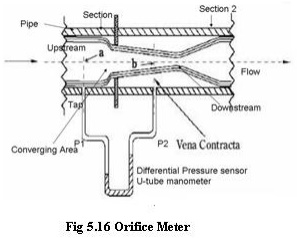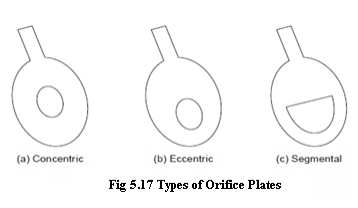Chapter: Mechanical : Metrology and Measurements : Measurement of Power, Flow and Temperature Related Properties
Orifice Flow Meter
Orifice Flow Meter
An Orifice flow meter is the most common head type flow measuring device. An orifice plate is inserted in the pipeline and the differential pressure across it is measured.
Principle of Operation
The orifice plate inserted in the pipeline causes an increase in flow velocity and a corresponding decrease in pressure. The flow pattern shows an effective decrease in cross section beyond the orifice plate, with a maximum velocity and minimum pressure at the venacontracta.

The flow pattern and the sharp leading edge of the orifice plate which produces it are of major importance. The sharp edge results in an almost pure line contact between the plate and the effective flow, with the negligible fluid-to-metal friction drag at the boundary.
Types of Orifice Plates
The simplest form of orifice plate consists of a thin metal sheet, having in it a square edged or a sharp edged or round edged circular hole.
There are three types of orifice plates namely
1. Concentric
2. Eccentric and
3. Segmental type.

The concentric type is used for clean fluids. In metering dirty fluids, slurries and fluids containing solids, eccentric or segmental type is used in such a way that its lower edge coincides with the inside bottom of the pipe. This allows the solids to flow through without any obstruction. The orifice plate is inserted into the main pipeline between adjacent flanges, the outside diameters of the plate being turned to fit within the flange bolts. The flanges are either screwed or welded to the pipes.
Applications
The concentric orifice plate is used to measure flow rates of pure fluids and has a wide applicability as it has been standardized
· The eccentric and segmental orifice plates are used to measure flow rates of fluids containing suspended materials such as solids, oil mixed with water and wet steam.
Advantages
· It is very cheap and easy method to measure flow rate
· It has predictable characteristics and occupies less space
· Can be used to measure flow rates in large pipes
Limitations
· The vena-contracta length depends on the roughness of the inner wall of the pipe and sharpness of the orifice plate. In certain case it becomes difficult to tap the minimum pressure due the above factor
· Pressure recovery at downstream is poor, that is, overall loss varies from 40 to 90% of the differential pressure.
· In the upstream straightening vanes are a must to obtain laminar flow conditions.
· The orifice plate gets corroded and due to this after sometime, inaccuracy occurs. The coefficient of discharge is low.
Related Topics